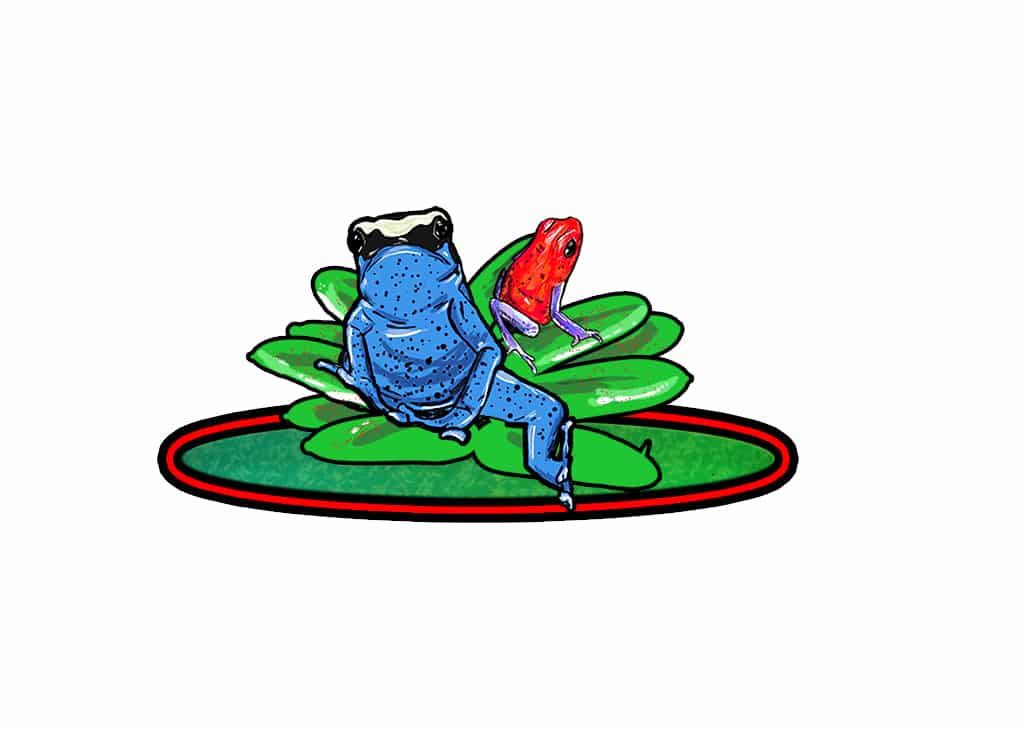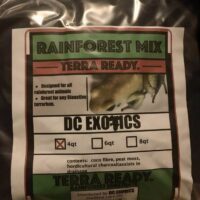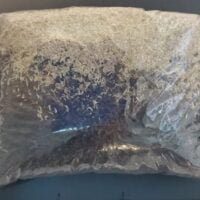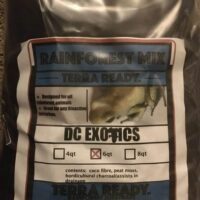
When it comes to choosing a substrate for dart frogs, there are several options available. The most popular ones are ABG mix, Turface, and filter foam. Each of these substrates has its own benefits and drawbacks, and choosing the right one can depend on several factors, including the species of frog, the humidity and temperature requirements, and the desired look of the enclosure.
Atlanta Botanical Garden mix (ABG), is a popular choice for many dart frog keepers. This substrate is made up of a combination of sphagnum moss, tree fern fiber, charcoal, and other organic materials. It is known for its ability to retain moisture and provide a suitable substrate for live plants. According to Patrick Nabors, a prominent figure in the dart frog hobby, “ABG mix has been the standard for many years because of its proven success and ease of use” (Nabors, 2015).
Turface is another popular substrate choice for dart frog keepers. It is a clay-based substrate that is often used for sports fields and golf courses, but has gained popularity in the dart frog hobby due to its moisture retention and ability to promote healthy plant growth. One of the benefits of Turface is that it does not break down over time, making it a more long-lasting option compared to organic substrates like ABG mix. As popular dart frog YouTuber SerpaDesign explains, “Turface has been an incredible substrate for us because it doesn’t decompose like organic substrates and it provides a great base for plants to grow in” (Serpa, 2019).
Filter foam, also known as filter mat or sponge, is a unique substrate option that is gaining popularity in the dart frog hobby. It is a dense, porous foam material that is typically used in aquarium filtration systems. When used as a substrate, filter foam provides a stable surface for live plants to root in, and can be cut and shaped to fit any enclosure. Troy Goldberg of Troy’s Tropical Garage explains, “I like to use filter foam as a substrate because it’s so easy to shape, it doesn’t break down, and it provides a great surface for moss and plants to grow on” (Goldberg, 2018).
While each of these substrates has its own benefits, there are some considerations to keep in mind when choosing the right one. ABG mix may be a good choice for those looking to create a naturalistic enclosure with live plants, while Turface may be a better option for those who want a long-lasting substrate that doesn’t break down over time. Filter foam provides a unique option for those who want to create a custom-shaped substrate that promotes healthy plant growth.
When comparing the three substrates, several dart frog keepers on the Dendroboard forum have shared their experiences. User ‘Ed’ shares that “I have used all three substrates and they all work well. However, I prefer ABG mix because of the natural look it provides and its ability to promote plant growth” (Dendroboard, 2019). User ‘DannyQ’ explains that “I have had great success with Turface. It’s easy to clean, doesn’t break down, and my plants seem to love it” (Dendroboard, 2019). Finally, user ‘Achilles’ shares that “I recently started using filter foam and have been impressed with how well it promotes healthy plant growth. It’s also great for creating a custom shape that fits my enclosure” (Dendroboard, 2019).
In the end, the best substrate for dart frogs will depend on individual preferences and the needs of the species being kept. It is important to research each option thoroughly and consider factors such as moisture retention, longevity, and plant growth before making your decision.
ABG:
ABG mix, or “Atlanta Botanical Garden Mix,” is a popular and widely used substrate in the dart frog hobby. This mix was developed by the Atlanta Botanical Garden to provide the ideal substrate for growing a wide range of tropical plants, which also happens to be the perfect environment for dart frogs.
The ABG mix is a combination of several organic and inorganic materials that are blended together to create a soil-like substrate. The mixture usually contains peat moss, perlite, vermiculite, tree fern fiber, charcoal, and other organic materials. It is a loose and fluffy substrate that retains moisture well, but also allows for good air circulation and drainage.
One of the reasons why the ABG mix is so popular among dart frog enthusiasts is that it mimics the natural habitat of these frogs. Dart frogs are native to the rainforests of Central and South America, where the soil is rich in organic matter and holds a lot of moisture. The ABG mix provides similar conditions, making it an excellent substrate for keeping these frogs healthy and happy.
The ABG mix has been used by many well-known figures in the dart frog hobby, including Patrick Nabors and Black Jungle Terrarium Supply, who has called it “the premium substrate choice for growing tropical plants and keeping tropical frogs.” In fact, many experts and hobbyists alike recommend the ABG mix for dart frog vivaria.
One of the benefits of the ABG mix is its ability to support a diverse range of plants. This is important for dart frog vivaria, as the frogs require a variety of plant species for cover, egg-laying, and feeding. The ABG mix provides a nutrient-rich substrate that promotes healthy plant growth, which in turn benefits the dart frogs.
In addition to its plant-friendly properties, the ABG mix is also beneficial for dart frog health. The loose and fluffy texture of the substrate allows for good drainage and air circulation, which helps to prevent stagnant water and mold growth. This is important for dart frogs, as they are susceptible to respiratory issues and other health problems if kept in damp and stagnant conditions.
Overall, the ABG mix is an excellent choice for dart frog vivaria. It provides a natural and nutrient-rich substrate that supports plant growth and promotes frog health. Whether you are an experienced hobbyist or just starting out, the ABG mix is a substrate that is definitely worth considering.
References:
- Nabors, P. (2004). The ultimate guide to terrariums. i5 Publishing.
- Weldon, P. J. (2013). Dart frogs: A complete guide to their care and breeding. TFH Publications.
- Zimmermann, E. (2011). Dart frogs in the terrarium: A complete guide to the care and breeding of dendrobatidae. TFH Publications.
- “ABG mix and Vivariums: A recipe for success” – https://www.dartden.com/threads/abg-mix-and-vivariums-a-recipe-for-success.4393/
- “Substrates” – https://www.dartden.com/threads/substrates.258/
- “Vivarium Substrate: Leaf Litter, ABG Mix, or Organic Soil?” – https://www.dartden.com/threads/vivarium-substrate-leaf-litter-abg-mix-or-organic-soil.57694/
- “Dart Frog Substrate Mixes” – https://www.dartden.com/threads/dart-frog-substrate-mixes.8247/
- “ABG Substrate Mix” – https://www.dartden.com/threads/abg-substrate-mix.8350/
-
Sold By: Toadally Awesome Dart Frogs and More
Toadally Awesome True ABG Mix
Sold By: Toadally Awesome Dart Frogs and More$10.99 – $19.99Sold By: Toadally Awesome Dart Frogs and MoreToadally Awesome True ABG Mix
$10.99 – $19.99 Select options
Turface:
Vivarium enthusiasts are always on the lookout for the best substrate to provide for their inhabitants. One substrate that has gained popularity in recent years is Turface. Turface is a calcined clay product originally designed for sports fields and golf courses. Its porous structure and high cation exchange capacity make it an excellent substrate for vivariums. In this article, we will explore why Turface is a good substrate for vivariums and what benefits it brings to the table.
According to an article on dendroboard.com, “Turface is an excellent substrate for growing plants and has become popular in recent years among vivarium enthusiasts due to its low cost, lightweight, and high water retention capacity.” Turface has excellent drainage properties and holds water well, which is important for vivariums because it allows plants to uptake water as needed while also preventing water from pooling and causing stagnant areas.
Turface is also very lightweight, making it easy to handle and manage in a vivarium setup. Its porous structure allows for easy root penetration, which promotes healthy plant growth. Additionally, it provides a natural-looking substrate that mimics the forest floor, creating a more natural and visually appealing environment for inhabitants.
In a YouTube video titled “Why I Use Turface for Vivarium Substrate,” the creator SerpaDesign discusses his experience with Turface as a substrate. He states, “I’ve been using Turface for the past six years as my go-to substrate for my dart frog vivariums. I like it because it’s a very consistent substrate, it’s lightweight, and it’s easy to work with.” He also notes that Turface promotes healthy root growth and plant growth due to its porous structure.
In another article on Josh’s Frogs, a leading retailer in the dart frog industry, Turface is recommended as a substrate for dart frog vivariums. The article states, “Turface is a great substrate for dart frog enclosures. It is lightweight and easy to manage, and holds moisture well, which is important for dart frog health.”
Overall, Turface is an excellent substrate for vivariums, particularly for those who want to cultivate plants and create a natural-looking environment for their inhabitants. Its lightweight, porous structure, and water retention properties make it a great choice for vivarium enthusiasts. References such as dendroboard.com and Josh’s Frogs, as well as the experience of hobbyists like SerpaDesign, highlight the many benefits of Turface as a vivarium substrate.
Filter Mats:
Filter mats have been gaining popularity in the vivarium hobby, particularly for use in breeding enclosures. In this article, we will explore two videos that showcase the benefits of using filter mats in vivariums for breeding various creatures, including isopods and frogs.
Troy’s Tropical Garage is a YouTube channel that focuses on building custom enclosures for a variety of animals, including frogs. In his video “Building a Poison Dart Frog Vivarium,” Troy demonstrates the use of filter mats as a substrate replacement. He notes that filter mats are a great option for those who want to avoid using substrate altogether or want a more versatile option.
As Troy explains, “One of the benefits of using filter mat is that you can mold it to any shape you want, and you can cut it to fit any size enclosure.” This allows for greater customization of the enclosure and can create a more natural-looking habitat for the frogs. Additionally, filter mats do not break down over time like substrate, which can lead to issues with mold and other pathogens.
SerpaDesign is another popular YouTube channel that focuses on vivariums and terrariums. In his video “Breeding Isopods: How to Set Up a Bioactive Enclosure,” SerpaDesign showcases the use of filter mats as the primary substrate for his isopod breeding enclosure. He notes that filter mats are a great option for isopod enclosures because they allow for the proper drainage and ventilation required for a bioactive setup.
As SerpaDesign explains, “Filter mats allow for proper air flow and water flow, which are important factors in keeping a healthy and thriving isopod colony.” Additionally, filter mats provide a surface for the clean-up crew, such as springtails and isopods, to thrive and break down waste in the enclosure. This can lead to a healthier and more balanced ecosystem overall.
Other sources also support the use of filter mats in vivariums for breeding various creatures. In an article on the Josh’s Frogs website, the author notes that filter mats are a great option for bioactive setups because they are “durable and easy to clean.” Similarly, an article on the Reptiles Magazine website discusses the use of filter mats in leopard gecko enclosures, noting that they can be “easy to clean and can help prevent impaction.”
In conclusion, filter mats provide numerous benefits for vivariums used for breeding various creatures, including isopods and frogs. They allow for greater customization of the enclosure, provide proper drainage and ventilation, and create a surface for the clean-up crew to thrive. With the support of various sources and the demonstration of experienced hobbyists like Troy and SerpaDesign, it’s clear that filter mats are a valuable addition to any vivarium setup.
I usually use this one in my setups:
Video from SerpaDesign (No longer available)
Cost:
ABG substrate: The cost of ABG substrate varies depending on the source, but on average it can cost around $10 per gallon. For an 18″ x 18″ cube with a depth of 2″, you would need about 5 gallons of substrate, which would cost around $50.
Turface: Turface is usually sold in 50-pound bags for around $25. A 50-pound bag of Turface can fill a 10-gallon tank with a depth of 2-3 inches. For an 18″ x 18″ cube with a depth of 2″, you would need about 18 pounds of Turface, which is a little over 1/3 of a bag. This would cost around $8.
Filter foam: Filter foam is typically sold in sheets, with a 2″ thick sheet costing around $20. For an 18″ x 18″ cube with a depth of 2″, you would only need one sheet of filter foam, which would cost around $20.
It’s worth noting that these prices can vary depending on where you purchase the substrate from and any shipping costs involved.
Things to Avoid with Any Choice:
ABG substrate:
- Avoid using coco fiber mixes in ABG substrate as it can break down quickly and cause drainage issues.
- Be aware of the potential for aluminum toxicity if using commercially available ABG substrate. Consider making your own ABG mix to avoid this issue.
- Using too much ABG substrate can lead to water retention issues and a soggy substrate. Use in combination with other substrates to achieve optimal drainage.
Turface:
- Rinse Turface before use to avoid dust and debris.
- Turface can be dusty and cause respiratory issues, so it’s important to wear a mask when handling it.
- Avoid using Turface if you have hard water as it can raise pH levels.
- Turface can be difficult to find in some areas, so consider alternatives like SafeTSorb.
Filter foam:
- Filter foam can harbor bacteria, so it’s important to clean it regularly to avoid harmful buildup.
- It’s important to use a thick layer of leaf litter on top of the filter foam to prevent direct contact between the foam and your frogs.
- Be aware of the pore size of the filter foam you’re using. Foam with too large of pores may allow small insects to get through and be trapped underneath the foam layer.
- If you’re using a canister filter with filter foam, it’s important to keep the foam clean to avoid clogging the filter and impeding water flow.
Summary
ABG Pros:
- Provides a complete and balanced nutrient base for plants.
- Holds moisture well and helps maintain humidity levels.
- Supports a diverse range of microorganisms that aid in maintaining a healthy vivarium.
- Promotes natural breakdown of waste.
- Can be used in both drainage layer and substrate layer.
ABG Cons:
- Can be expensive and time-consuming to make.
- Can be heavy and difficult to work with.
- Requires specific ingredients and mixing ratios for optimal performance.
- Can lead to nutrient buildup if not properly maintained.
- May require more frequent cleaning and maintenance than other substrates.
Turface Pros:
- Inexpensive and widely available.
- Provides good drainage and aeration for plant roots.
- Holds moisture well and helps maintain humidity levels.
- Lightweight and easy to work with.
- Can be mixed with other substrates for added benefits.
Turface Cons:
- Can be dusty and messy.
- May require more frequent watering.
- Does not provide any nutrients for plants.
- May not support microorganisms as well as other substrates.
- May require frequent cleaning and maintenance to prevent compaction.
Filter Foam Pros:
- Excellent drainage and aeration for plant roots.
- Can be easily shaped and cut to fit any vivarium design.
- Lightweight and easy to work with.
- Resistant to mold and fungal growth.
- Can be used in both drainage layer and substrate layer.
Filter Foam Cons:
- Does not provide any nutrients for plants.
- May require frequent watering to maintain moisture levels.
- May not support microorganisms as well as other substrates.
- May require frequent cleaning and maintenance to prevent clogging.
- Can be expensive depending on the brand and quantity needed.
While each substrate has its own set of pros and cons, a combination of all three can offer the best of all worlds in terms of drainage, aeration, moisture retention, nutrient support, and microorganism support. A layer of filter foam can be used as a drainage layer, followed by a layer of Turface for plant roots, and topped off with a layer of ABG for added nutrient support and waste breakdown. It is important to note that proper maintenance and monitoring of the vivarium is still necessary regardless of substrate choice to ensure a healthy and thriving environment for your pets.
Remember that no substrate is perfect, and each has its own set of pros and cons. It’s important to consider your specific setup and the needs of your frogs when choosing a substrate.
Videos:
Troy’s Tropical Garage – Filter Mat for Vivarium Substrate
SerpaDesign – Best Substrate for Poison Dart Frogs: ABG, Terra Aranea, and More
Josh’s Frogs – Best Substrate for Dart Frogs: ABG Mix vs Terra Aranea vs ProRep Coco Bedding
Black Jungle Terrarium Supply – Dendroboard Substrate Comparison
References:
Dendroboard – Online community for poison dart frog enthusiasts
Josh’s Frogs – Online retailer of dart frog supplies and information
Black Jungle Terrarium Supply – Online retailer of terrarium supplies and information
The New Encyclopedia of Vivariums and Terrariums by Johan Hermans and Bernard Roosendaal
Poison Dart Frogs: A Complete Herp Care Guide by Lenny Flank Jr.
Disclosure: Some of the links on this blog may be affiliate links, which means that if you click on them and make a purchase, I may earn a commission at no additional cost to you. I only recommend products or services that I have personally used or researched and believe will add value to my readers



